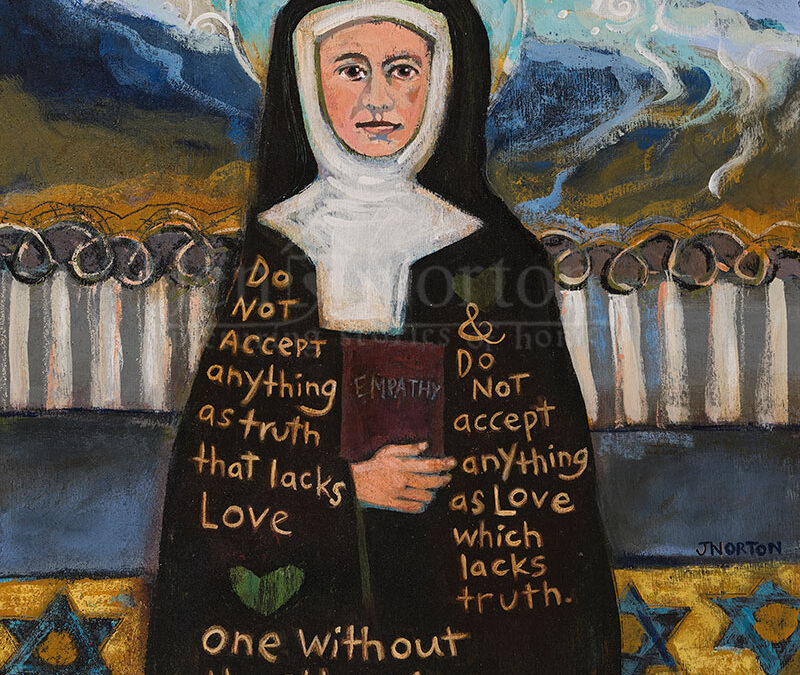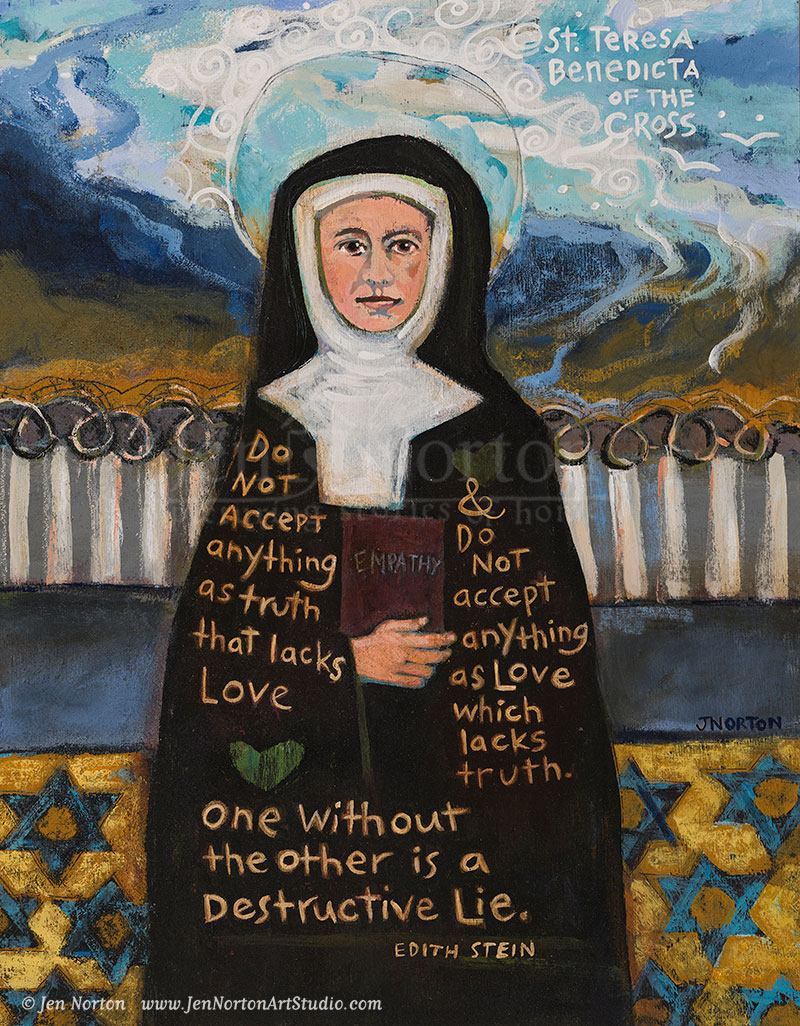“St. Teresa Benedicta of the Cross” by Jen Norton. 11×14″ Acrylic on Canvas, $750
While working on this painting of St. Teresa Benedicta of the Cross (aka Edith Stein), I was reminded of the color theory law of “simultaneous contrast.” This law states that a one color can change how we perceive the tone or hue of another color when the two are placed side by side. Colors are each true to themselves; it is only our perception that changes. A dull color, for example, will appear more intense next to a neutral color or a color might seem darker or lighter depending on the value of what’s around it. And who can forget that striped dress on social media a few years back where no one could agree in its color? Yes, our eyes can deceive us. We cannot always rely on our own judgement.
It’s a little funny that this law would come to mind given that, of all the paintings I’ve done over the years, this one is one of the least colorful. Most of the art is painted in two hues: yellow and blue, both toned down in most cases. It is the juxtaposition of these simple colors with the neutrals that makes them seem colorful at all.
Likewise, it was in the twists and turns of her life that Edith found the truth of an unchangeable God. And it was in the ever-changing winds of her soul’s evolution that Edith found her true center. Where we might pity her for her earthly difficulties, her life reminds us that while our eyes may deceive us, God’s artistry is always at play.
The Life of Edith Stein
The life of Edith Stein was, in a way, a simultaneous contrast. Edith was born to a Jewish family in Poland and was the youngest of 11 children. In her teen years, she rejected her family’s religion and became an atheist as a young woman. The bottom gold stars in this painting call to mind her Jewish roots, and the dull gray area above it represents the emptiness of devotion in atheism.
She became highly educated in philosophy and history, and after years as an atheist, she encountered a biography of St. Teresa of Avila which powerfully convinced her to become Catholic. Upon baptism into a new faith, her academic and spiritual life pivoted to match. Her doctoral dissertation was On the Problem of Empathy, a work that still inspires readers on how to see others and the experiences of others with charity and love.
The many shifts and questions posed in her life provided the contrast of clarity with the truth she found: That Love and Truth are inseparable.
Edith entered the Carmelite Convent of Cologne and took the Christian name Teresa Benedicta of the Cross. As anti-semitism gained traction across Europe in 1930s, her prioress smuggled her to the Netherlands to the convent in Echt. In 1942, she was arrested by the Gestapo along with hundreds of others and she was deported to Auschwitz where she was murdered in a gas chamber along with her sister a few days later.
In the painting, the dull ochre tendrils of gas from the death chambers rise to become the beautiful swirls of the clouds of heaven. St. Teresa Benedicta of the Cross stands firmly centered here, anchored in spite of the varying patterns in the background. The many shifts and questions posed in her life provided the contrast of clarity with the truth she found: That Love and Truth are inseparable.
God Alone Suffices
Edith Stein’s life was full of twists and turns which took her from her Jewish roots all the way to Catholic martyrdom. Her story, and the colors of this piece, are heavy, but viewing them in contrast to her spiritual life reminds us of how radiant the love of God is in comparison. The darkness of her time in Auschwitz makes her faith, charity, and martyrdom that much more intense and vibrant.
In our current world we are faced with the unexpected trials of a pandemic and the effects of climate change. We are subjected daily to polarizing opinions, opinions on those opinions, and lies crafted for political gain. It can be hard to know what is true and it can be traumatizing to feel so out of control. St. Teresa Benedicta reminds us that Truth is a product of Love and Love with lies attached is not Love at all. She urges us to stay still and centered, close our judgmental eyes, and hear the timeless truth of God’s Love that never changes.






